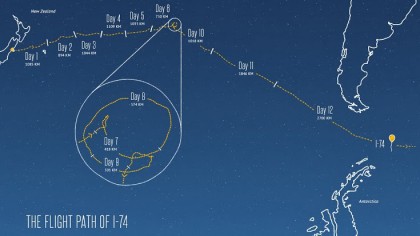Project Loon explained: Can Google's balloons unite the world online?
A load of hot air or an idea of stratospheric magnitude?
Sorry to pop your balloon, but…
Google makes it all sound pretty straightforward doesn't it? Could this latest Google X Labs "moonshot" really become a reality?
"No," said famed balloonist and aeronautical engineer Per Lindstrand, emphatically.
"I talked to them [Google] about it. I told them it was a waste of time, but they didn't listen," said the Swede, whose attempts to fly around the world with Sir Richard Branson have entered into legend.
"Balloons blow away. Wind speeds at that altitude can reach up to 120 knots, so they won't stay there for more than a minute."
Yeah, but surely Google can do that bit where they keep their Loon balloons in the air for 100 days, allowing the custom-built steering mechanism to keep them on track?
Another categorical "No" from Per. "No-one has been able to do that before."
"Normally a helium balloon at altitude can only stay up for 3-4 days, and if you set off a lot of balloons simultaneously around the world, sooner or later they're just going to collect at the North Pole or the South Pole. They can't stay in position."
Get daily insight, inspiration and deals in your inbox
Sign up for breaking news, reviews, opinion, top tech deals, and more.
"If you want them to be stationary, use an airship and use the sun as your power source and a fuel cell. That's the way to do it."
Get out of our airspace
It's not just the physical challenges that threaten to undermine Google's utopian vision for a connected world. Can you imagine the political hoops Google would need to jump through in order to make this work?
Is it remotely feasible that governments in China, Russia, North Korea and others would freely allow Google's balloons to operate in its airspace, potentially harvesting data from the ground below?

As there's no international agreement on the scope of a nation's vertical airspace, it's sort of a grey area. The Karman Line, defined as the boundary between the Earth's atmosphere and outer space, is one suggested benchmark. That sits at 62 miles above sea level, way above Google's Loon balloons.
Lindstrand wasn't particularly optimistic either. "Airspace is defined well above where these balloons are flying, so they will be in these countries' airspace. China can deny them access, of course they would. There's no question about it."
Even if Google were able to manoeuvre around the airspace issue, even if its intentions are totally pure, making Project Loon a reality is probably as much about diplomacy as it is about technology.
As The Atlantic's Will Butler writes: "What would Vladimir Putin think if he looked up to see an aircraft run by a US tech giant - one that occasionally shares data with the NSA, no less - dangling overhead? What if a few Loons had to take a rest stop over Pyongyang?"
Google doesn't particularly have a clean record when it comes to 'inadvertently' picking up public data either. There are a myriad of privacy concerns that come with Google's plan, both for those using the Wi-Fi and the countries within their airspace.

It's also debatable whether the lack of Wi-Fi is the real issue here for underprivileged in some parts of the world. Phares Kariuki, a former technology consultant to the World Bank said the price of internet-enabled gear is preventing people getting online.
"In Kenya, most parts of the country have 3G access," he told the MIT Technology Review. "The barrier to Internet adoption is not so much the lack of connectivity. It's the high cost of the equipment."
However, the plans to give every 7-year old in Kenya a laptop could relieve those problems somewhat.
Google's plans have also drawn ire from Microsoft-pioneer-turned-philanthropist Bill Gates, who thinks the web giant should be using its vast resources on tackling more urgent problems.
"When you're dying of malaria, I suppose you'll look up and see that balloon, and I'm not sure how it'll help you. When a kid gets diarrhoea, no, there's no website that relieves that," he sniped.
So what happens now?
Since its test in New Zealand, Google has gone quiet about Project Loon. It's been almost a month since its last video update on Google+ and our request for an interview for this piece was shut down.
At this point, it is possible there are hundreds of Loon balloons in the sky; that the project is much further along than we're all currently aware. Having gone public with its proof of concept exercises, it seems more likely than not that Google will go all-out with this one.
However, the technological, ethical and political challenges remain. Can Google's Project Loon rise above them with its latest "moonshot?"
As W Clement Stone wrote: "Always aim for the Moon, even if you miss, you'll land among the stars."
A technology journalist, writer and videographer of many magazines and websites including T3, Gadget Magazine and TechRadar.com. He specializes in applications for smartphones, tablets and handheld devices, with bylines also at The Guardian, WIRED, Trusted Reviews and Wareable. Chris is also the podcast host for The Liverpool Way. As well as tech and football, Chris is a pop-punk fan and enjoys the art of wrasslin'.
